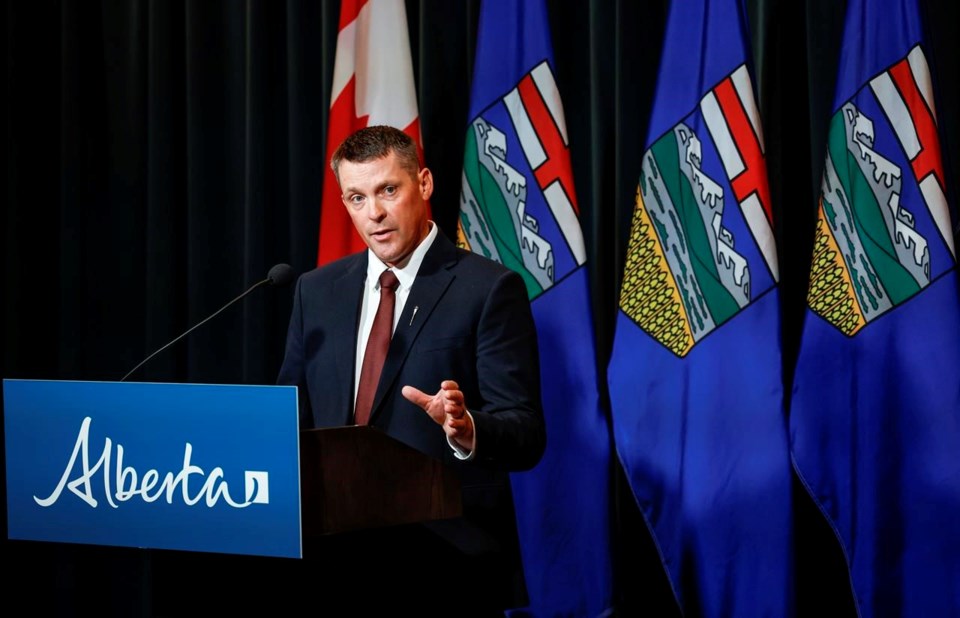EDMONTON — Alberta’s budget surplus is growing, but will be offset by more than $1 billion this year to pay for floods, forest fires and drought.
Finance Minister Nate Horner says the province is on track to record a $5.5-billion surplus when the 2023-24 budget year ends in March.¬Ý
That is a $3.2-billion increase from the surplus predicted when the budget was introduced in February.
The extra money is due mainly to oilsands royalties and higher personal and corporate income taxes, bringing the total estimated government revenue to $74.3 billion, set against $68.8 billion in spending.
“Alberta's economy is resilient, and our finances are on track," Horner told reporters Thursday as he delivered the second-quarter budget update.
“Our energy sector continues to be a driver of jobs and activity, and at the same time we're seeing growth and diversification in emerging sectors like tech and aviation.”
He added: “We're aware of the many challenges the current global economy presents. Rising costs, higher interest rates and general economic uncertainty are weighing on businesses and consumers.
“We’re not immune to these challenges, but we’re in a strong position to weather them.”
Horner announced royalties from the oilsands are projected to be almost $2 billion higher than expected for a total of $14.4 billion.
Tax revenues will be more than a billion dollars higher than expected, coming in at $26.3 billion, with sharp rises in revenue from both personal and corporate levies.
On the spending side, total outlays are going up by almost $2 billion, but much of it will be covered off by transfers from the contingency fund and revenue increases.
The big-ticket spending increase is fighting natural disasters.
The United Conservative government is allocating $1.2 billion to pay for the response to spring wildfires and summer flooding, and for livestock producers contending with dry conditions.
The cost of fighting the fires is expected to be $750 million, and another $253 million is to cover off financial assistance to communities for uninsurable damage from the wildfires and floods.¬Ý
The bill for evacuation and other supports comes in at $61 million. There will be $165 million in relief for livestock producers dealing with dry conditions.¬Ý
There is also about $300 million in extra spending in Health to pay for physician compensation, the new federal-provincial funding deal and Alberta’s recently announced top-to-bottom restructuring of health-service delivery.
Opposition NDP finance critic Samir Kayande says Alberta’s good fortune is cold comfort to those not sharing in it,
“It is in fact the actions of this government that see Albertans continue to struggle with their basic needs despite high resource revenues and the provincial surplus,” Kayande told reporters.
“Alberta has had the lowest wage growth at several points under the UCP, and pay here has been massively outpaced by inflation.
“The UCP is making false promises, touting increased levels of migration while refusing to acknowledge that those who answered their call likely won't be able to afford a place to live, keep up with the cost of their basic needs, or access public services in a timely way.”
Among the other numbers, taxpayer-supported debt is expected to fall by $3 billion to land at about $76 billion by March as the province continues to make payments.
The nest egg Heritage Savings Trust Fund has grown slightly and now has a market value of $21.4 billion.
The government is set on Jan. 1 to resume its tax on gasoline. The 13-cent-per-litre levy was paused in 2023.
Based on a sliding scale tied to oil prices, it will resume at nine cents per litre in the new year.
Alberta’s economic outlook remains rosy.
Real GDP is expected to grow 2.8 per cent, in line with forecasts from the February budget.
Alberta has added 78,000 new jobs since the start of the year, including 68,000 full-time positions.
The population continues to grow. Alberta added 184,000 people for 4.1 per cent growth in the 2023 census year and that figure is expected to rise another 2.9 per cent in the 2024 census year.
This report by The Canadian Press was first published Nov. 30, 2023.
Dean Bennett, The Canadian Press




